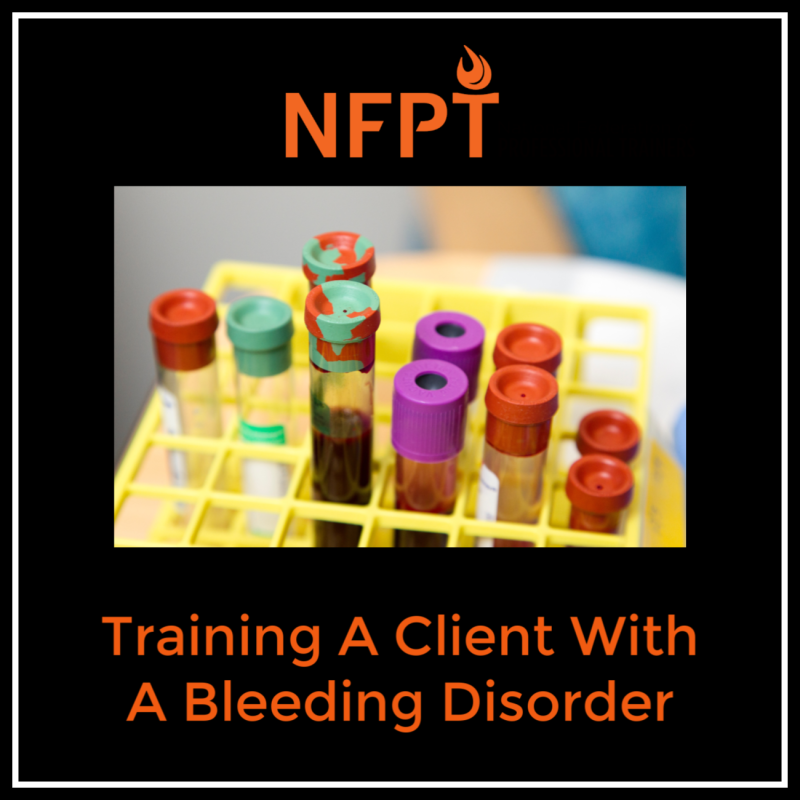
Everyone should have the ability to exercise and express the activity that their bodies are designed to exhibit, but sometimes more careful consideration of the client’s unique needs is required. Since March is Bleeding Disorder Awareness Month, I wanted to take this opportunity to explain the basics of bleeding disorders, and some of the unique needs that clients presenting with a bleeding disorder may have in order to ensure their safety.
What are bleeding disorders?
The term bleeding disorder is essentially a broad classification of various disease pathologies (usually some form of clotting factor deficiency) that result in an inability to clot. Clotting is a normal function that many of us take for granted, but for people with bleeding disorders that are missing one factor or another for this clotting process to occur, minor scrapes can turn into major problems.
The elderly client that may not necessarily have a bleeding disorder, but could be on blood thinners, aspirin, or blood pressure medication that may increase their risk for bruises and bleeding. It is especially important that you limit the traumatic contact that these individuals may sustain over the course of their exercise regimens as, again, what may be minor injuries could result in bigger issues for that client as well.
What Can Trainers Do?
As professional trainers, we are not medical professionals seeking to treat bleeding disorders by any means. Our efforts should always be focused on ensuring safe exercise activities for the client following the clearance from a licensed medical professional. Our role can be broken down into two categories: Prevention and Response.
Prevention
Limiting external injuries: With this type of client, we will want to limit the potential for trauma by choosing exercises carefuly While this may seem straight forward at first, there are some complications that we will want to talk about as well.
In order to limit external injuries, we want to limit the opportunity for impact on the client’s person. This may reduce the amount of medicine balls we are throwing, or the amount of ropes they are jumping. If the client misses ball with the hands and it impacts the chest, the client could develop massive bruising of the chest area, or could have an internal bleeding emergency.
Similarly, for jumping rope, missing the rope could result in catching the clients shins, which would result in more serious bruising than usual. It could also cause the client to trip and fall, which could result in injury or even death as was the case in Queen Elizabeth’s son who was one of the initial carriers of this family of pathologies. (He didn’t die by jump rope, but a fall in his early thirties leading to a massive hemorrhage.)
Limiting internal injuries: In mentioning an impact to the chest, I briefly touched on internal injuries. Any impact to these clients may result not only in bruising or exterior blood loss but could also cause potential injury on the internal organs as well. Blood can be lost both ways–out of the body as well as into the extravascular space (referring to just any space outside of the arteries, veins, capillaries, etc…places where blood is supposed to be.)
This topic is a bit more tricky and is especially important where clearance from the client’s physician will come into play. If there is a substantial risk, it is likely that the physician won’t clear the client for physical activity, which at first doesn’t sound great–but could result in crisis aversion.
The next important thing to be aware of is the signs and symptoms that something has gone wrong following physician clearance for activity. Many of these are symptoms that we should be watching for regularly anyways, but just for the sake of clarity and specification- we’re going to touch on a few major ones. Please be aware though that this is not an exhaustive list, and encourage the client to listen to their body as always!
Intracranial Hemorrhage:
- Sudden headache
- Nausea/vomiting
- Sensitivity to light
Bleeding into the joint spaces:
- Tingling in the joints
- Pain in the joints
- Limited ROM
- Joint may become hot or swollen
An important consideration regarding intracranial hemorrhage: there are some exercises that increase intracranial pressure (commonly abbreviated ICP). Again, assuming this client has been cleared to work with a certified trainer rather than a licensed health professional- it may be best to leave deadlifts out of the workout regimen. Other exercises that may be best left out include anything that has the client lying flat (in a supine position or at a decline) in favor of exercises where the head is elevated 30 degrees from the hips. This maintains ICP, which will reduce the risk.
Response
The next important piece we need to consider is the appropriate response to what appears to be an internal or external bleeding injury. Unfortunately, even when we manage to do everything right to mitigate our risk by asking for clearance from a licensed professional and picking our workouts selectively to reduce the client’s risk of injuries, things can still go wrong. This is where our emergency response procedure needs to be planned out in advance. We need to have drilled it in or have easy reference to what should be done (or if you’re taking yourself and the client’s health seriously- both need to be done) As an EMT, I know that in dire situations it is easy to forget the most basic things, and sometimes your hands become like seal flippers, which isn’t very helpful for doing much at all.
[Drawing] Here are a few basic tips to help your response in a potentially dire situation:
- Plan and Drill: Practicing your response makes it a reaction rather than something you have to think about.
- Know where the emergency supplies are in your gym: This may include things like AED’s in the case of cardiac arrest, but also includes first aid kits that will have things like bandages, gauze, and gloves.
- GET YOUR FIRST AID CERTIFICATION: Yeah, we all know how to pump hard and fast to the beat of staying alive in the case of cardiac arrest because we’re required to, but how many of us were trained to take care of that bleeding until the ambulance arrives? Increase your knowledge! Helpful courses may include first aid as well as Stop the Bleed. While the first aid course is more likely to come in handy as personal trainers, Stop the Bleed goes one step further- and unfortunately in the world we live in- may allow you to save a life even in the worst acts of random violence out and about.
- Know the emergency numbers in your area: I can’t harp on this enough. Everyone is bad enough on pulling their phones out in an emergency anymore, don’t be that guy or gal that needs to google the emergency number for help. 911 is a safe bet, but I have also seen this backfire depending on your locale. It is best to have the direct number for dispatch.
Summary
When and if a client may present with a bleeding disorder, your #1 job is going to be ensuring their safety in the gym. This includes having clearance from their licensed medical provider to be participating in physical activity in the first place. After this clearance is obtained, plan an appropriate workout that will limit their risks for both internal and external hemorrhage that is sustainable due to the disorder, and ensure that your emergency plan is in place prior to needing it.
Now that you’re in the know, get out there and empower your clients to pursue this expression of themselves!
References
Effects of Position on Intracranial Pressure
https://www.ncbi.nlm.nih.gov/pubmed/9413447
Types of Bleeding Disorders
https://www.hemophilia.org/Bleeding-Disorders/Types-of-Bleeding-Disorders
Types of Bleeds
https://www.hemophilia.org/Bleeding-Disorders/Types-of-Bleeds
GET FIRST AID CERTIFIED:
https://www.redcross.org/take-a-class/first-aid






